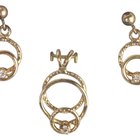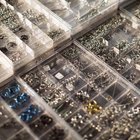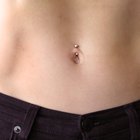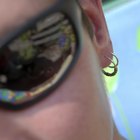
Daniel Sroga/iStock/Getty Images
Belly button rings may look cute, but they're a care-intensive piercing. If you're going to get your navel pierced, you'll have to deal with potential chronic infection, long healing times, allergies and medical concerns, as well as clothing restrictions and other daily annoyances. It's important to consider the disadvantages along with the advantages before you go under the needle.
Rejection and Infection
Whenever you get any type of piercing, infection becomes a serious concern. Navel piercings are most likely to get infected than any other type of piercing, according to India Parenting. Your belly button and the skin surrounding the piercing area easily collect sweat and bacteria. Your clothing continually comes in contact with the piercing site, depositing bacteria and causing friction and irritation. Common activities like sitting or sleeping can irritate the site and lead to infection. In a small percentage of people, the body rejects piercings and pushes them out of the body as skin heals. Skin may heal with a forked appearance once your body pushes the piercing all the way out.
Injury
If your belly button ring gets caught on something, like a shirt or belt, it can tear through your skin. Body piercings bleed more and typically cause larger injuries when pulled out than earrings do, according to Shari Nethersole, M.D., writing for Family Education. Common activities like dressing, tossing and turning during sleep, swimming, exercising or having sex all pose risks for pulling out your piercing.
Medical Risks
While most piercing establishments follow health and safety codes to the letter, those who don't expose their clients to a wide range of diseases like HIV and hepatitis C, according to Teens Health. Some people, especially women, are allergic to the material in the equipment or piercing and experience painful itching, irritation and swelling. If your piercer isn't careful, he or she can inflict permanent nerve damage or pierce a major blood vessel.
Weight Gain and Pregnancy
During pregnancy or after a significant weight gain, you might find your piercing gets stretched out, moves, becomes newly infected or feels tight. If you gain weight above and below your waistline, you might trap your piercing in between stomach pouches when you sit down. Sweat and bacteria easily collect in these areas, leading to chronic infection or, at the very least, discomfort. A tight, pregnant belly can put pressure against the piercing and labor can cause your piercing to tear out. Ofter childbirth, you may not be able to wear your belly button ring until your stomach goes back to its normal size, during which time the piercing hole could close.
Minor Inconveniences
Your piercing might not cause you any major medical pitfalls, but it can cause you some minor daily annoyance. If your work requires you to wear a specific uniform, you might find it causes chafing or rubs against your piercing. You might have to put a spacer in while you're at work. If you use certain types of metal in your piercing, it could set off metal detectors or show up on both medical or security X-ray machines. You might find the rigorous cleaning regimen tedious. You may also find you have trouble changing your piercing and have to regularly return to the shop for new jewelry.
Related Articles

What You Need to Know About ...

How to Get a Guiche Piercing

How Long After Piercing Can You Change ...

How Long Do You Keep Your Earrings in ...

Problems With Nose Piercings

How to Get Rid of Belly Button Odor

The Pros & Cons of Getting Your Belly ...

How to Pierce Your Navel

How to Stretch Ears With Tape

How to Gauge Your Ears Without Tapers

Complications of Nipple Piercing

How Is Nipple Piercing Performed?

What Is Bio-Flex Made of for Piercings?

How to Drain a Cheek Piercing

What If They Make a Mistake When ...

How to Stop Pierced Ears From Seeping

What to Do When a Nose Ring Falls Out

How to Keep a Piercing From Rejecting

How to Remove a Navel Piercing

Places to Pierce Your Ear
References
Writer Bio
A Jill-of-all-trades, Lillian Downey is a certified Responsible Sexuality Educator, certified clinical phlebotomist and a certified non-profit administrator. She's also written extensively on gardening and cooking. She also authors blogs on nail art blog and women's self esteem.
Photo Credits
Daniel Sroga/iStock/Getty Images